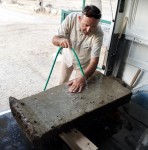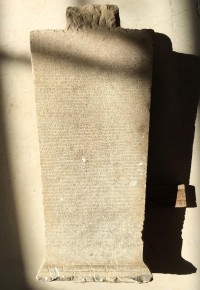 An archaeological excavation of the ancient Greek city of Teos on the west coast of modern-day Turkey has unearthed a marble tablet inscribed with an incredibly detailed leasing contract. The tablet was discovered west of the early 2nd century B.C. Temple of Dionysus, the largest temple to Dionysus in the ancient world which according to Vitruvius was built by famed Hellenistic architect Hermogenes of Priene. One of 400 tablets discovered at Teos (200 unearthed since 2010), the stele is five feet long and contains an impressive 58 lines of Greek text.
An archaeological excavation of the ancient Greek city of Teos on the west coast of modern-day Turkey has unearthed a marble tablet inscribed with an incredibly detailed leasing contract. The tablet was discovered west of the early 2nd century B.C. Temple of Dionysus, the largest temple to Dionysus in the ancient world which according to Vitruvius was built by famed Hellenistic architect Hermogenes of Priene. One of 400 tablets discovered at Teos (200 unearthed since 2010), the stele is five feet long and contains an impressive 58 lines of Greek text.
The inscription covers the minutiae of a lease on property in the city’s gymnasium. In ancient Greece, the gymnasium was an open-air facility for training for athletic contests like the Olympics and other public games, general physical education, scholarly disquisitions on and discussion of philosophy, art and literature. As all public games were religious festivals whose outcomes held portentous meaning to the participating cities, the gymnasia were usually carefully regulated by the local authorities.
 The tablet illuminates the pivotal role played by the gymnasium in Teos as well as exploring previously unknown details about the city’s laws and social order. The gymnasium students, known as Neos, had inherited a substantial property from a resident of Teos. He donated his land, all of the buildings on it, the slaves attached to it and an altar to the Neos who were not kids, but citizens between the ages of 20 and 30. Of course maintenance of property, buildings, human chattel and religious shrines takes money, which the Neos didn’t have, so they had to rent the land in order to keep it.
The tablet illuminates the pivotal role played by the gymnasium in Teos as well as exploring previously unknown details about the city’s laws and social order. The gymnasium students, known as Neos, had inherited a substantial property from a resident of Teos. He donated his land, all of the buildings on it, the slaves attached to it and an altar to the Neos who were not kids, but citizens between the ages of 20 and 30. Of course maintenance of property, buildings, human chattel and religious shrines takes money, which the Neos didn’t have, so they had to rent the land in order to keep it.
Because of the altar on the land, the property was categorized as holy and therefore exempt from taxes. The Neos wanted use of the holy altar, so they included a codicil allowing them access to the altar three days in the year. They put the land up for auction — just for lease, not for sale — and it was rented to the highest bidder. The tablet records the name of the previous owner and of the lessor. One guarantor and six witnesses, three of them city administrators, were required to validate the agreement.
“This inscription reveals the structure of the Gymnasium and that the Neos were able to own a property. This is first and only example in the ancient world. Almost half of the inscription is filled with punishment forms. If the renter gives damage to the land, does not pay the annual rent or does not repair the buildings, he will be punished. The Neos also vow to inspect the land every year,” said [Professor Mustafa Adak, the head of Akdeniz University’s Prehistoric Languages and Cultures Department].
“There are two particularly interesting legal terms used in the inscription, which large dictionaries have not up to now included. Ancient writers and legal documents should be examined in order to understand these words mean,” Adak said.
The Neos were citizens closely involved in the political life of the city. The renter would not have been wise to mess with them because all those punishments literally carved into stone could and certainly would be enforced.
I love that the legalese on the tablet retains its impenetrability even to experts in ancient languages 2,200 years after it was written.